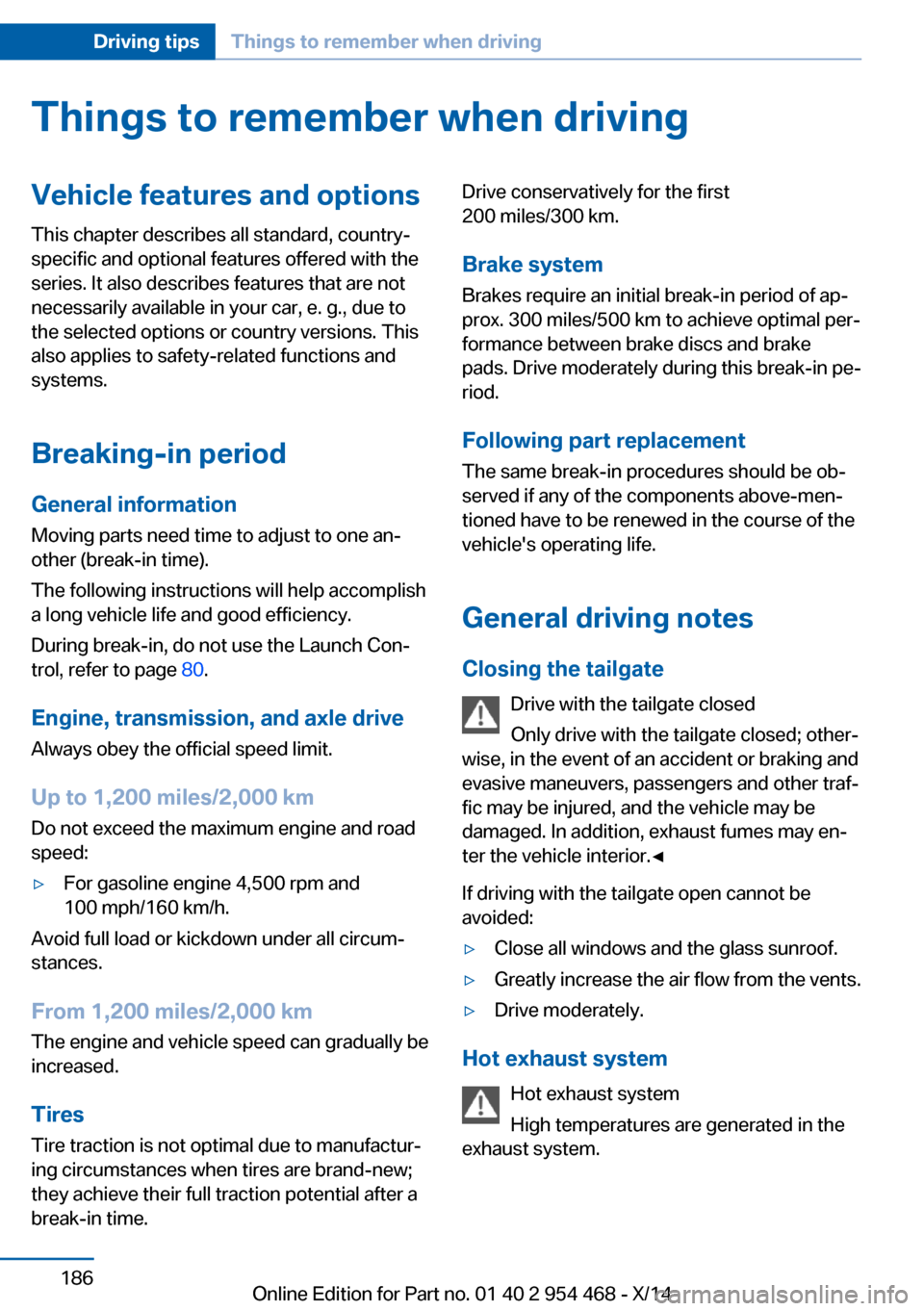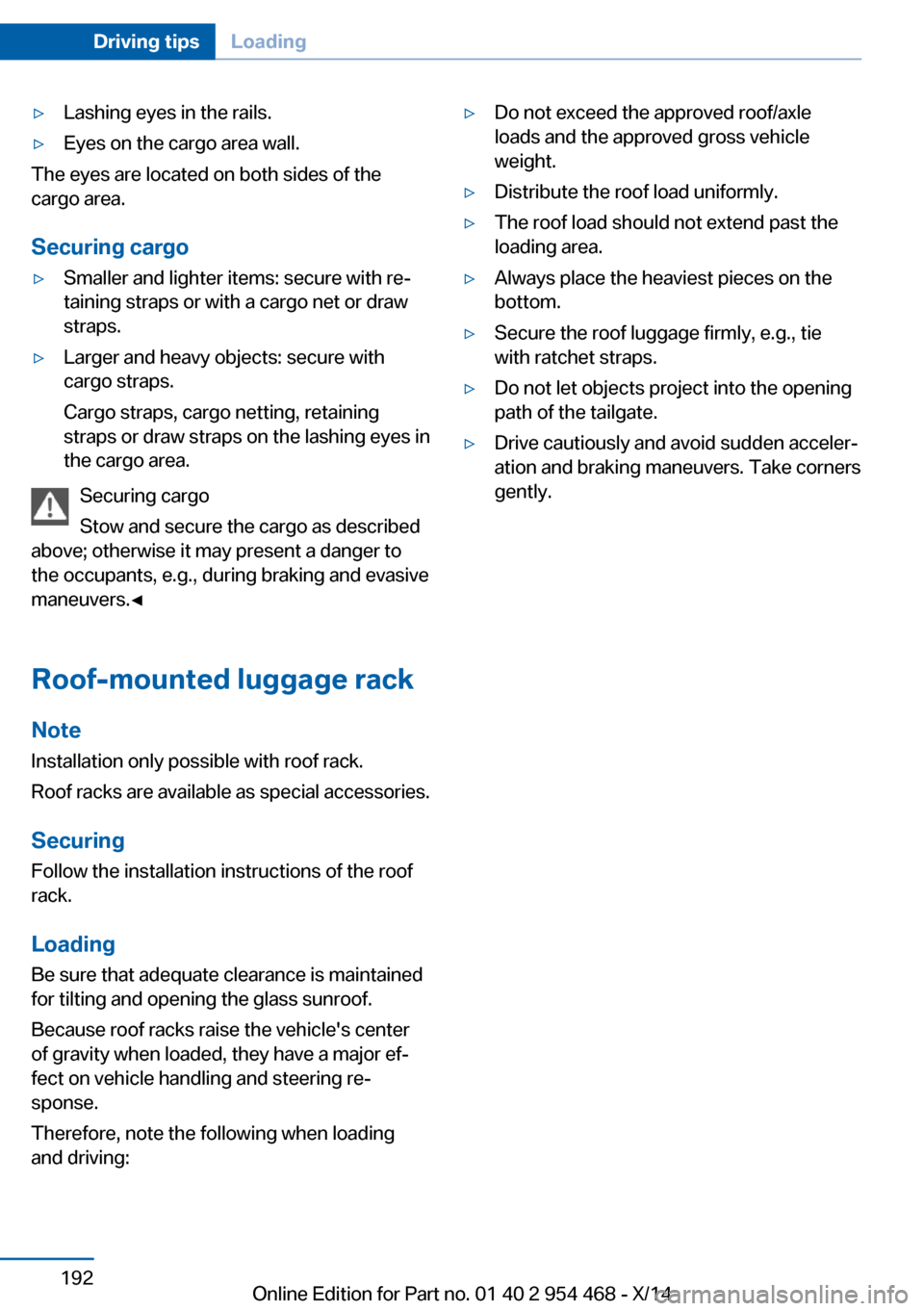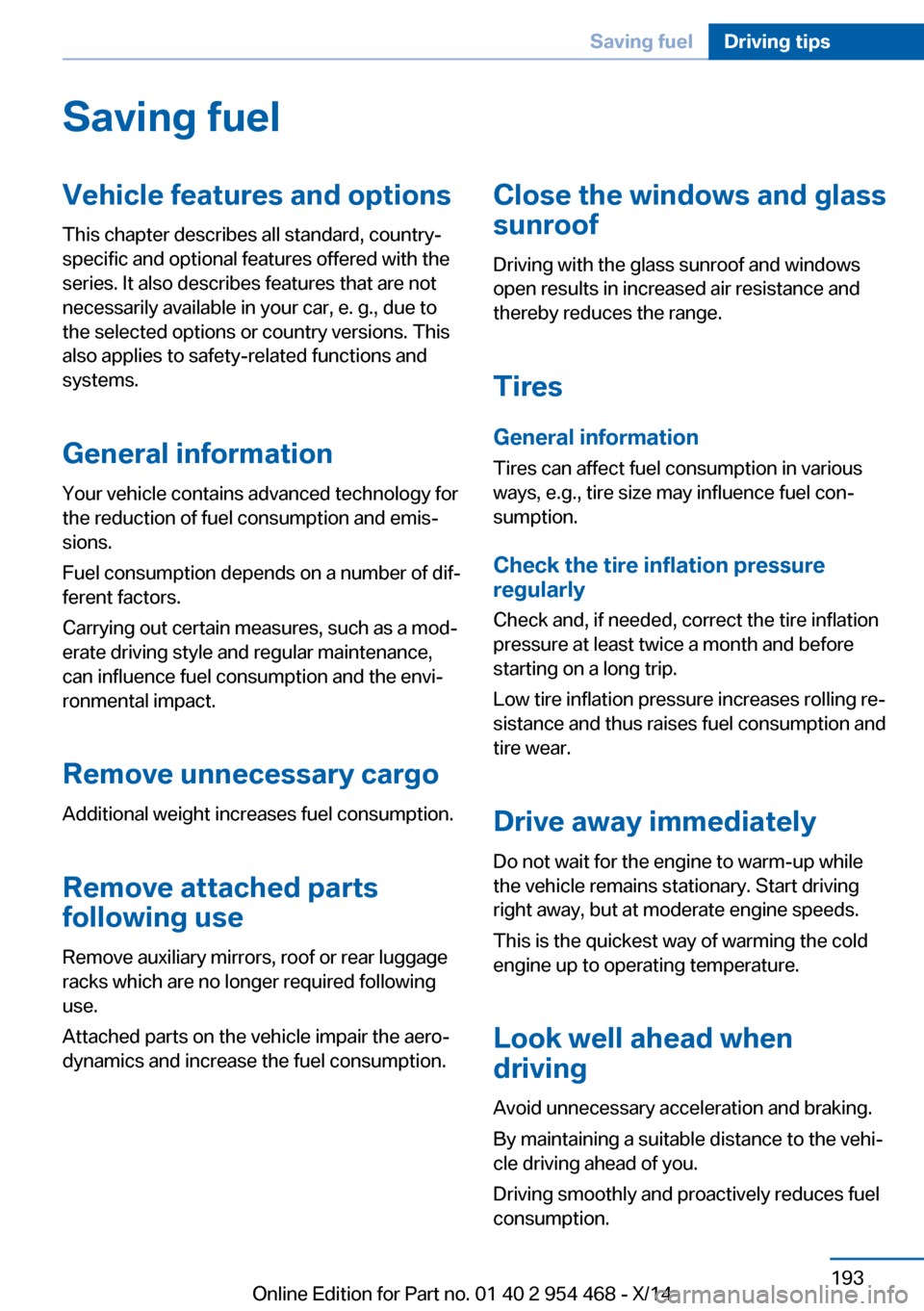2014 BMW X6 sunroof
[x] Cancel search: sunroofPage 190 of 259

Things to remember when drivingVehicle features and options
This chapter describes all standard, country-
specific and optional features offered with the
series. It also describes features that are not
necessarily available in your car, e. g., due to
the selected options or country versions. This
also applies to safety-related functions and
systems.
Breaking-in period
General information Moving parts need time to adjust to one an‐
other (break-in time).
The following instructions will help accomplish
a long vehicle life and good efficiency.
During break-in, do not use the Launch Con‐
trol, refer to page 80.
Engine, transmission, and axle drive Always obey the official speed limit.
Up to 1,200 miles/2,000 km
Do not exceed the maximum engine and road
speed:▷For gasoline engine 4,500 rpm and
100 mph/160 km/h.
Avoid full load or kickdown under all circum‐
stances.
From 1,200 miles/2,000 km The engine and vehicle speed can gradually be
increased.
Tires
Tire traction is not optimal due to manufactur‐
ing circumstances when tires are brand-new;
they achieve their full traction potential after a
break-in time.
Drive conservatively for the first
200 miles/300 km.
Brake system
Brakes require an initial break-in period of ap‐
prox. 300 miles/500 km to achieve optimal per‐
formance between brake discs and brake
pads. Drive moderately during this break-in pe‐
riod.
Following part replacement
The same break-in procedures should be ob‐
served if any of the components above-men‐
tioned have to be renewed in the course of the
vehicle's operating life.
General driving notes
Closing the tailgate Drive with the tailgate closed
Only drive with the tailgate closed; other‐
wise, in the event of an accident or braking and
evasive maneuvers, passengers and other traf‐
fic may be injured, and the vehicle may be
damaged. In addition, exhaust fumes may en‐
ter the vehicle interior.◀
If driving with the tailgate open cannot be
avoided:▷Close all windows and the glass sunroof.▷Greatly increase the air flow from the vents.▷Drive moderately.
Hot exhaust system
Hot exhaust system
High temperatures are generated in the
exhaust system.
Seite 186Driving tipsThings to remember when driving186
Online Edition for Part no. 01 40 2 954 468 - X/14
Page 196 of 259

▷Lashing eyes in the rails.▷Eyes on the cargo area wall.
The eyes are located on both sides of the
cargo area.
Securing cargo
▷Smaller and lighter items: secure with re‐
taining straps or with a cargo net or draw
straps.▷Larger and heavy objects: secure with
cargo straps.
Cargo straps, cargo netting, retaining
straps or draw straps on the lashing eyes in
the cargo area.
Securing cargo
Stow and secure the cargo as described
above; otherwise it may present a danger to
the occupants, e.g., during braking and evasive
maneuvers.◀
Roof-mounted luggage rack Note
Installation only possible with roof rack.
Roof racks are available as special accessories.
Securing
Follow the installation instructions of the roof
rack.
Loading Be sure that adequate clearance is maintained
for tilting and opening the glass sunroof.
Because roof racks raise the vehicle's center
of gravity when loaded, they have a major ef‐
fect on vehicle handling and steering re‐
sponse.
Therefore, note the following when loading
and driving:
▷Do not exceed the approved roof/axle
loads and the approved gross vehicle
weight.▷Distribute the roof load uniformly.▷The roof load should not extend past the
loading area.▷Always place the heaviest pieces on the
bottom.▷Secure the roof luggage firmly, e.g., tie
with ratchet straps.▷Do not let objects project into the opening
path of the tailgate.▷Drive cautiously and avoid sudden acceler‐
ation and braking maneuvers. Take corners
gently.Seite 192Driving tipsLoading192
Online Edition for Part no. 01 40 2 954 468 - X/14
Page 197 of 259

Saving fuelVehicle features and optionsThis chapter describes all standard, country-
specific and optional features offered with the
series. It also describes features that are not
necessarily available in your car, e. g., due to
the selected options or country versions. This
also applies to safety-related functions and
systems.
General information
Your vehicle contains advanced technology for
the reduction of fuel consumption and emis‐
sions.
Fuel consumption depends on a number of dif‐
ferent factors.
Carrying out certain measures, such as a mod‐
erate driving style and regular maintenance,
can influence fuel consumption and the envi‐
ronmental impact.
Remove unnecessary cargoAdditional weight increases fuel consumption.
Remove attached parts
following use
Remove auxiliary mirrors, roof or rear luggage
racks which are no longer required following
use.
Attached parts on the vehicle impair the aero‐
dynamics and increase the fuel consumption.Close the windows and glass
sunroof
Driving with the glass sunroof and windows
open results in increased air resistance and
thereby reduces the range.
Tires
General information Tires can affect fuel consumption in various
ways, e.g., tire size may influence fuel con‐
sumption.
Check the tire inflation pressure
regularly
Check and, if needed, correct the tire inflation
pressure at least twice a month and before
starting on a long trip.
Low tire inflation pressure increases rolling re‐
sistance and thus raises fuel consumption and
tire wear.
Drive away immediately
Do not wait for the engine to warm-up while
the vehicle remains stationary. Start driving
right away, but at moderate engine speeds.
This is the quickest way of warming the cold
engine up to operating temperature.
Look well ahead when
driving
Avoid unnecessary acceleration and braking.
By maintaining a suitable distance to the vehi‐
cle driving ahead of you.
Driving smoothly and proactively reduces fuel
consumption.Seite 193Saving fuelDriving tips193
Online Edition for Part no. 01 40 2 954 468 - X/14
Page 231 of 259

Further information about the battery can be
obtained from your service center.
Battery replacement Use approved vehicle batteries only
Only use vehicle batteries that have been
approved for your vehicle by the manufacturer;
otherwise, the vehicle could be damaged and
systems or functions may not be fully availa‐
ble.◀
After a battery replacement, have the battery
registered on the vehicle by your service cen‐
ter to ensure that all comfort features are fully
available and that any Check Control mes‐
sages of these comfort features are no longer
displayed.
Charging the battery
Note Do not connect charging devices to the
12 volt socket in the vehicle
Do not connect battery chargers to the fac‐
tory-installed 12 volt sockets in the vehicle as
this may damage the vehicle battery due to an
increased power consumption.◀
General information
Make sure that the battery is always suffi‐
ciently charged to guarantee that the battery
remains usable for its full service life.
The battery may need to be charged in the fol‐
lowing cases:▷When making frequent short-distance
drives.▷If the vehicle is not used for prolonged pe‐
riods, longer than a month.
Starting aid terminals
In the vehicle, only charge the battery via the
starting aid terminals, refer to page 231, in the
engine compartment with the engine off.
Power failure
After a temporary power loss, some equipment
needs to be newly initialized or individual set‐
tings updated, e.g.:▷Seat, mirror, and steering wheel memory:
store the positions again.▷Time: update.▷Date: update.▷Glass sunroof: initialize the system, refer to
page 49.
Disposing of old batteries
Have old batteries disposed of by your
service center or bring them to a recy‐
cling center.
Maintain the battery in an upright position for
transport and storage. Secure the battery so
that it does not tip over during transport.
Fuses Hints Replacing fuses
Never attempt to repair a blown fuse and
do not replace a defective fuse with a substi‐
tute of another color or amperage rating; this
could lead to a circuit overload, ultimately re‐
sulting in a fire in the vehicle.◀
Plastic tweezers and information on the fuse
types and locations are stored in the fuse box
in the cargo area.
Seite 227Replacing componentsMobility227
Online Edition for Part no. 01 40 2 954 468 - X/14
Page 238 of 259

CareVehicle features and optionsThis chapter describes all standard, country-
specific and optional features offered with the
series. It also describes features that are not
necessarily available in your car, e. g., due to
the selected options or country versions. This
also applies to safety-related functions and
systems.
Car washes
General information
Regularly remove foreign objects such as
leaves in the area below the windshield when
the hood is raised.
Wash your vehicle frequently, particularly in
winter. Intense soiling and road salt can dam‐
age the vehicle.
Hints Steam jets or high-pressure washers
When using steam jets or high-pressure
washers, hold them a sufficient distance away
and use a maximum temperature of
140 ℉/60 ℃.
If the vehicle has a glass sunroof, ensure that a
distance of at least 31.5 inches/80 cm is main‐
tained. Holding them too close or using exces‐
sively high pressures or temperatures can
cause damage or preliminary damage that may
then lead to long-term damage.
Follow the user's manual for the high-pressure
washer.◀
Cleaning sensors/cameras with high-
pressure washers
When using high-pressure washers, do not
spray the exterior sensors and cameras, e.g.,
Park Distance Control, for extended periods oftime and only from a distance of at least
12 in/30 cm.◀
Automatic car washes
Hints Note the following:▷Give preference to cloth car washes or
those that use soft brushes in order to
avoid paint damage.▷Make sure that the wheels and tires are not
damaged by the transport mechanisms.▷Fold in the exterior mirrors; otherwise, they
may be damaged, depending on the width
of the vehicle.▷Deactivate the rain sensor, refer to
page 75, to avoid unintentional wiper acti‐
vation.▷In some cases, an unintentional alarm can
be triggered by the interior motion sensor
of the alarm system. Follow the instruc‐
tions on avoiding an unintentional alarm,
refer to page 46.
Guide rails in car washes
Avoid car washes with guide rails higher
than 4 in/10 cm; otherwise, the vehicle body
could be damaged.◀
Different types of tires Observing vehicle width
Before entering washing systems, make
sure that the vehicle width is not too great for
the car wash; otherwise, there could be dam‐
age to the vehicle and car wash.◀
Seite 234MobilityCare234
Online Edition for Part no. 01 40 2 954 468 - X/14
Page 251 of 259

Energy recovery 91
Engine, automatic reel-off 69
Engine, automatic Start/Stop function 69
Engine compartment 212
Engine compartment, work‐ ing in 212
Engine coolant 217
Engine idling when driving, coasting 196
Engine oil 214
Engine oil, adding 215
Engine oil additives 215
Engine oil change 216
Engine oil filler neck 215
Engine oil temperature 89
Engine oil types, alterna‐ tive 216
Engine oil types, ap‐ proved 216
Engine start during malfunc‐ tion 35
Engine start, jump-start‐ ing 231
Engine start, refer to Starting the engine 68
Engine stop 68
Engine temperature 89
Entering a car wash 234
Equipment, interior 169
Error displays, see Check Control 85
ESP Electronic Stability Pro‐ gram, refer to DSC 133
Exchanging wheels/tires 209
Exhaust system 186
Exterior mirror, automatic dimming feature 60
Exterior mirrors 59
External start 231
External temperature dis‐ play 89
External temperature warn‐ ing 89
Eyes for securing cargo 191 F
Failure message, see Check Control 85
False alarm, refer to Uninten‐ tional alarm 46
Fan, refer to Air flow 163
Filler neck for engine oil 215
Fine wood, care 236
First aid kit 230
Fitting for towing, see tow fit‐ ting 233
Flat tire, changing wheels 224
Flat Tire Monitor FTM 111
Flat tire, Tire Pressure Moni‐ tor TPM 107
Flat tire, warning lamp 108, 111
Flooding 187
Floor carpet, care 237
Floor mats, care 237
Fold-out position, wiper 76
Foot brake 187
Front airbags 104
Front center armrest 179
Front cupholder 181
Front-end collision warning with braking function 116
Front-end collision warning with City Braking func‐
tion 113
Front fog lights 102
Front fog lights/cornering lights, bulb replace‐
ment 224
Front fog lights, bulb replace‐ ment 224
Front lights 223
front-seat passenger airbags, automatic deactivation 106
Front-seat passenger airbags, indicator lamp 106
Front seats 51
FTM Flat Tire Monitor 111
Fuel 202 Fuel consumption, current 90
Fuel consumption, refer to Average fuel consump‐
tion 94
Fuel filler flap 200
Fuel gauge 89
Fuel lid 200
Fuel quality 202
Fuel recommendation 202
Fuel, tank capacity 242
Fuse 227
G
Garage door opener, refer to Universal Integrated Remote
Control 169
Gasoline 202
Gear change, Steptronic transmission 77
Gear shift indicator 92
General driving notes 186
Glare shield 171
Glasses compartment 180
Glass sunroof, powered 48
Glove compartment 178
Gross vehicle weight, ap‐ proved 241
H
Handbrake, refer to Parking brake 70
Hand-held transmitter, alter‐ nating code 170
Hazard warning flashers 229
HDC Hill Descent Con‐ trol 135
Head airbags 104
Headlight control, auto‐ matic 100
Headlight courtesy delay fea‐ ture 99
Headlight flasher 74
Headlight glass 222
Headlights 223 Seite 247Everything from A to ZReference247
Online Edition for Part no. 01 40 2 954 468 - X/14
Page 254 of 259

Opening/closing via doorlock 39
Opening and closing 34
Opening and closing, without remote control 39
Opening and closing, with re‐ mote control 37
Opening the tailgate with no- touch activation 43
Operating concept, iDrive 18
Optional equipment, standard equipment 6
Outside air, refer to Auto‐ matic recirculated-air con‐
trol 164
Overheating of engine, refer to Coolant temperature 89
P Paint, vehicle 235
Parallel parking assistant 158
Park Distance Control PDC 149
Parked-car ventilation 167
Parked vehicle, condensa‐ tion 188
Parking aid, refer to PDC 149
Parking assistant 158
Parking brake 70
Parking lights 99
Parking with Automatic Hold 71
Passenger side mirror, tilting downward 59
Pathway lines, rearview cam‐ era 153
PDC Park Distance Con‐ trol 149
Pedestrian detection, see Night Vision 122
Pedestrian warning with city braking function 119
Personal Profile 35
Personal Profile, exporting profiles 36 Pinch protection system,
glass sunroof 49
Pinch protection system, win‐ dows 47
Plastic, care 236
Power failure 227
Power sunroof, glass 48
Power windows 47
Pressure, tire air pres‐ sure 204
Pressure warning FTM, tires 111
Profile, refer to Personal Pro‐ file 35
Programmable memory but‐ tons, iDrive 24
Protective function, glass sunroof 49
Protective function, win‐ dows 47
Push-and-turn reel, refer to Controller 18, 19
R Radiator fluid 217
Radio-operated key, refer to Remote control 34
Radio ready state 67
Radio, see user's manual for Navigation, Entertainment
and Communication
Rain sensor 75
Rear automatic climate con‐ trol 166
Rear center armrest 180
Rear cooler 174
Rear drink holder 181
Rear lights 224
Rear seats 55
Rearview camera 151
Rearview mirror 59
Rear window defroster 164
Recirculated-air mode 164
Recommended fuel grade 202 Recommended tire
brands 210
Refueling 200
Remaining range 90
Remote control/key 34
Remote control, malfunc‐ tion 38
Remote control, univer‐ sal 169
Replacement fuse 227
Replacement wheel 225
Replacing parts 221
Replacing wheels/tires 209
Reporting safety defects 9
RES button 143
RES button, see Active Cruise Control, ACC 140
RES button, see Cruise con‐ trol 147
Reserve warning, refer to Range 90
Reset, Tire Pressure Monitor TPM 108
Residual heat, automatic cli‐ mate control 165
Retaining straps, securing cargo 191
Retreaded tires 210
Roadside parking lights 100
Roller sunblinds 48
RON recommended fuel grade 202
Roofliner 17
Roof load capacity 241
Roof-mounted luggage rack 192
Rope for tow-starting/ towing 232
RSC Run Flat System Com‐ ponent, refer to Run-flat
tires 211
Rubber components, care 236
Run-flat tires 211 Seite 250ReferenceEverything from A to Z250
Online Edition for Part no. 01 40 2 954 468 - X/14